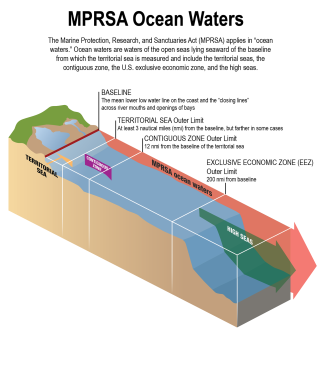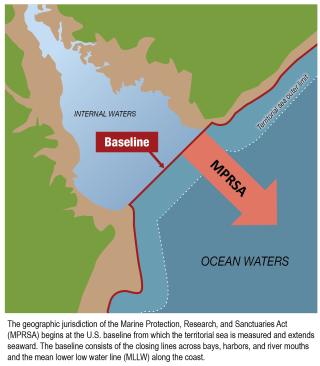Marine Protection, Research and Sanctuary Act Permits: Frequently Asked Questions
- What kinds of permits are issued under the MPRSA?
- When is an MPRSA permit required?
- Who needs an MPRSA permit?
- What criteria does the EPA use to evaluate applications for MPRSA permits?
- Who issues MPRSA permits?
- What is the relationship between MPRSA and other federal, state or international requirements?
- What types of conditions are included in MPRSA permits?
- How does the MPRSA apply to ocean carbon dioxide removal (CDR) or solar radiation management (SRM) activities (also called marine geoengineering)?
What kinds of permits are issued under the MPRSA?
MPRSA section 102 gives the EPA the authority to issue various categories of permits, including general permits, special permits, emergency permits and research permits, for materials other than dredged material.
Under section 103 of the MPRSA, the United States Army Corps of Engineers may issue MPRSA permits for dredged material and must apply MPRSA requirements directly to federal projects involving ocean dumping of dredged material. The EPA reviews MPRSA section 103 permits for concurrence, concurrence with conditions or non-concurrence based on MPRSA criteria.
For more information about permits issued under the MPRSA:
- MPRSA General Permits
- MPRSA Research Permits
- MPRSA Permits for Dredged Material
- MPRSA Emergency Permits
- MPRSA Special Permits
- MPRSA and Fish Wastes
When is an MPRSA Permit required?
Unless specifically excluded or exempt from MPRSA, an MPRSA permit is required for the transportation and "dumping" of any material into "ocean waters". Section 106 of the MPRSA voids any license, permit and authorization other than an MPRSA permit to the extent that it purports to authorize an activity regulated by the MPRSA. An MPRSA permit is not needed for activities that are specifically exempt from permitting under the MPRSA or for the disposition of material from activities that do not occur in ocean waters.
- "Dumping" means a disposition of material. The MPRSA uses the term "dumping" and defines it broadly to encompass "the disposition of material" both for the purpose of disposal and for purposes other than disposal. There are exemptions to the definition of dumping, including "construction of a fixed structure or artificial island" or "placement of a device" for a purpose other than disposal and where the construction or placement is otherwise regulated under another law.
- The MPRSA applies in "ocean waters". Ocean waters include the open seas lying seaward of the "baseline" of the territorial seas. In general terms, the baseline is the mean lower low water line, or ordinary low water mark, along the coast and the "close lines" across river mouths and openings of bays that are depicted on official United States Nautical Charts.
"Ocean waters" for the purposes of the MPRSA include:- The territorial seas (the first three miles seaward of the baseline).
- The contiguous zone (the next nine miles -- from three to twelve miles seaward of the baseline).
- The ocean and high seas beyond the contiguous zone of the United States extending to the exclusive economic zone of another country.
Click on the image to view a larger version.
Click on the image to view a larger version.
Who needs an MPRSA permit?
Anyone conducting an activity that involves the release of material into ocean waters may require a permit under the MPRSA, though there are exclusions from the definition of dumping and separate exceptions from the permit requirement. Entities who may apply for or seek authorization under an MPRSA permit include:
- Anyone transporting material from the United States for the purpose of dumping it into ocean waters. Dumping includes activities that involve releasing materials in the ocean for disposal and certain non-disposal purposes.
- Anyone in a vessel or aircraft registered in the United States or flying the United States flag transporting material from any location for the purpose of dumping it into ocean waters.
- Any United States department, agency or instrumentality transporting material from any location for the purpose of dumping it into ocean waters.
- Any other person dumping material transported from a location outside the United States into the territorial sea of the United States, or into a zone contiguous to the territorial sea of the United States, to the extent that it may affect the territorial sea or the territory of the United States.
What criteria does the EPA use to evaluate applications for MPRSA permits?
The EPA published marine protection criteria at 40 CFR 227 and 228 for review and evaluation of permit applications. The marine protection criteria consider, among other things:
- the need for the activity, including land-based alternatives for the proposed activity;
- the environmental impact of the activity, including its effect on marine ecosystems, shorelines and beaches;
- the effect of the activity on esthetic, recreational or economic values; and
- the adverse effect of the activity on other uses of the ocean including navigation, scientific study, fishing and resource exploitation activities.
Who issues MPRSA permits?
The EPA issues MPRSA permits for materials other than dredged materials. The EPA issues MPRSA General Permits, Emergency Permits, Research Permits, and Special Permits.
More information about MPRSA permitting by the EPA, including contact information.
The U.S. Army Corps of Engineers (USACE) is the permitting authority for the dumping of dredged material into the ocean. Dredged material refers to material excavated or dredged from the navigable waters of the United States.
The USACE applies the EPA’s marine protection criteria to determine whether to authorize the disposition of dredged material under MPRSA permits (or, in the case of federal projects, to dump dredged material in the ocean itself). MPRSA permits for and federal projects involving dredged material are subject to the EPA's review and concurrence.
What is the relationship between MPRSA and other federal, state or international requirements?
The inter-governmental consultation or coordination requirements for MPRSA permits are determined on a case-by-case basis depending on the nature and location of the ocean dumping activity. Entities that or with which the EPA may notify, consult or coordinate with include:
- Tribal governments (more information on the EPA's Tribal consultation policies);
- Relevant state entities to satisfy the applicable analytical and substantive requirements of the Coastal Zone Management Act, Clean Water Act section 401 and National Historic Preservation Act;
- The National Oceanic and Atmospheric Administration's National Marine Fisheries Service as applicable under the Endangered Species Act, Magnuson-Stevens Fishery Conservation and Management Act and Marine Mammal Protection Act;
- U.S. Fish and Wildlife Service as applicable for consultation requirements under the Endangered Species Act;
- U.S. Coast Guard regarding permit conditions to facilitate surveillance, enforcement and safety at sea;
- USACE regarding matters related to any adverse impacts to navigation or harbor approaches;
- U.S. Department of the Interior regarding the Outer Continental Shelf Lands Act; and
- Potentially affected countries and relevant international bodies (more information about MPRSA and the London Convention and London Protocol international treaties).
What types of conditions are included in MPRSA permits?
MPRSA permits specify:
- the type of material authorized to be transported for disposition;
- the amount of material authorized to be transported for disposition;
- the location where the transport will be terminated or disposition of a material will occur;
- such requirements, limitations or conditions as are necessary to assure consistency with any approved site management plan pursuant to MPRSA section 102(c);
- any special provisions for the monitoring and surveillance of the permitted activity; and
- any such matters that the EPA, or in the case of the disposition of dredged material into the ocean the EPA or USACE, as the case may be, deems appropriate.
How does the MPRSA apply to marine carbon dioxide removal (mCDR) or solar radiation management (mSRM) activities (also called marine geoengineering)?
The MPRSA regulates the transportation and disposition of materials into the ocean unless a specific disposition or specific material is expressly excluded. An MPRSA permit may be needed for field research, large-scale field trials, and field deployment of mCDR or mSRM activities if the activities involve the disposition of material into the ocean environment.
More information on Marine Carbon Dioxide Removal and Solar Radiation Management Permitting.


